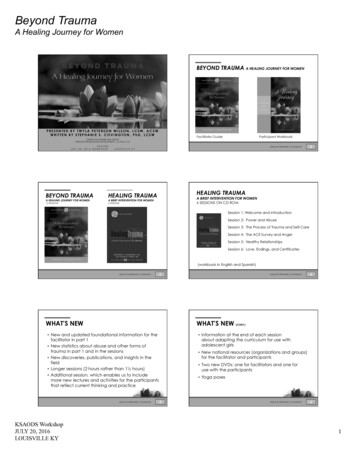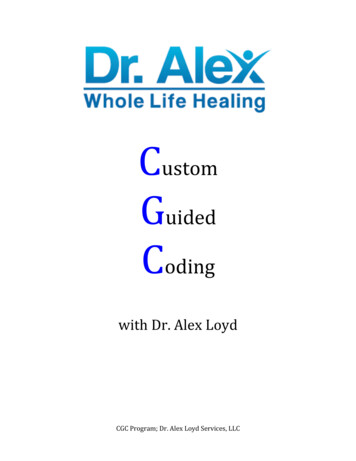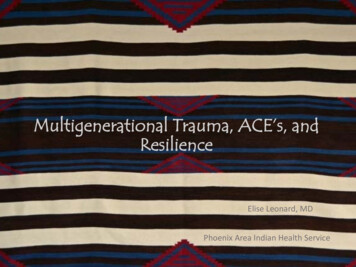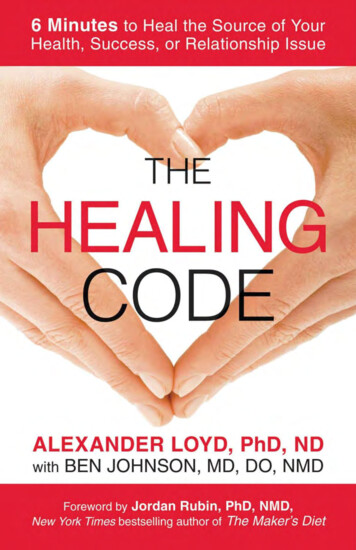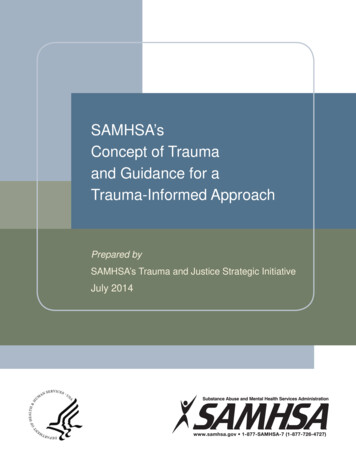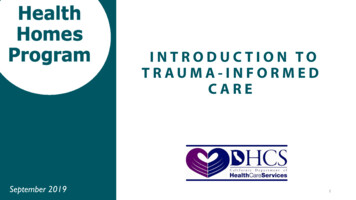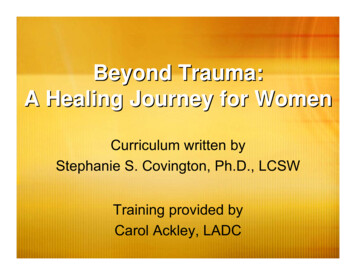
Transcription
Beyond Trauma:A Healing Journey for WomenCurriculum written byStephanie S. Covington, Ph.D., LCSWTraining provided byCarol Ackley, LADC
Crisis Danger & Opportunity
Levels of Violence Childhood Adolescence Adult Street (workplace and community) Consumer Culture Media War Planet
Two Kinds of Suffering Natural Created
Definition of TraumaThe diagnostic manual used by mental health providers(DSM IV-TR) defines trauma as, “involving directpersonal experience of an event that involves actual orthreatened death or serious injury, or other threat toone’s physical integrity; or a threat to the physicalintegrity of another person; or learning aboutunexpected or violent death, serious harm, or threat ofdeath or injury experienced by a family member or otherclose associate.”(American Psychiatric Assoc. [APA] 2000, pg. 463).
Definition of Trauma (cont.)“The person’s response to the event must involveintense fear, helplessness or horror (or in children,the response must involve disorganized or agitatedbehavior).”(American Psychiatric Assoc. [APA] 2000, pg. 463).
Violence Against WomenViolence against women is so pervasive that the UnitedNations has addressed and defined violence againstwomen as “any act of gender-based violence thatresults in, or is likely to result in, physical, sexual orpsychological harm or suffering to women, includingthreats of such acts, coercion or arbitrary deprivationsof liberty, whether occurring in public or private life.”(United Nations General Assembly, 1993).
Gender-Responsive ServicesGender-ResponsivenessCreating an environment through site selection,staff selection, program development, content, andmaterial that reflects an understanding of therealities of the lives of women and girls and thataddresses and responds to their strengths andchallenges.(Covington & Bloom)
Theoretical FoundationThe theories related to gender and substanceabuse (and any other relevant treatmentservices) that create the framework of thoughtfor program development.This is theknowledge base that creates the foundationupon which the program is developed.
Treatment StrategiesThe approaches used in the program thatcreate the therapeutic process. These arethe ways in which theory is operationalized(how theory is applied).
Women’s Issues:An International Perspective Shame and Stigma Physical and Sexual Abuse Relationship Issues fear of losing children fear of losing partner needing partner’s permissionto obtain treatment
Women’s Issues:An International Perspective Treatment Issues lack of services for womennot understanding treatmentlong waiting listslack of childcare services Systemic Issues lack of financial resources lack of clean/sober housing poorly coordinated services
The ing Trust in othersand in yourself Courage todo new things To like yourselfas a womanThe Future Conflicts Relationships Relapseprevention Workingtogether SocialplanningLotta Länne, Sweden, 2006
Helping Women Recover:A Comprehensive Integrated Approach Theory of Addiction Holistic health model Chronic neglect of self in favor of something orsomeone else Theory of Women’s Psychological Development Relational–Cultural Model (Stone Center) Theory of Trauma Three Stage Model (Herman) Upward Spiral – A Transformational Model (Covington)
Voices: A Program of Self-discovery andEmpowerment for Girls Theory of Girls’ Psychological Development Relational–Cultural Model (Stone Center, Gilligan, Brown)Theory of Attachment Ainsworth, Bowlby, Harlow, SternTheory of Trauma Three Stage Model (Herman) Transformational Spiral (Covington)Theory of Resilience Biscoe, Wolin & WolinTheory of Addiction Holistic Health Model
Beyond Trauma: A Healing Journeyfor WomenTrauma TheorySandra Bloom, M.D.Mary Harvey, Ph.D.Judith Herman, M.D.Peter Levine, Ph.D.et al.Integrates cognitive-behavioral, expressive arts,guided imagery, and relational therapy.
“Therapeutic culture”has these elements Attachment: a culture of belongingContainment: a culture of safetyCommunication: a culture of opennessInvolvement: a culture of participation andcitizenship Agency: a culture of empowerment(Haigh)
Three Critical andInterrelated Issues Substance Abuse Mental Health Trauma
Relational-Cultural TheorySome women use drugs: To maintain a relationship To fill in the void of what’s missing in arelationship To self-medicate the pain of abuse inrelationships(Covington & Surrey, 1997)
Trauma-informed Services These are services that are provided forproblems other than trauma but requireknowledge about violence against women andthe impact of trauma thereby increasing theireffectiveness.
Trauma-informed ServicesTrauma-informed services:1. Take the trauma into account.2. Avoid triggering trauma reactions and/ortraumatizing the individual.3. Adjust the behavior of counselors, other staff andthe organization to support the individual’s copingcapacity.4. Allow survivors to manage their trauma symptomssuccessfully so that they are able to access, retainand benefit from the services.(Harris & Fallot)
Ten Principles ofTrauma-Informed ServicesPrinciple 1.Trauma-Informed Services Recognize the Impact ofViolence and Victimization on Development andCoping Strategies
Ten Principles ofTrauma-Informed Services (cont.)Principle 2.Trauma-Informed Services Identify Recovery fromTrauma as a Primary Goal
Ten Principles ofTrauma-Informed Services (cont.)Principle 3.Trauma-Informed Services Employ an EmpowermentModel
Ten Principles ofTrauma-Informed Services (cont.)Principle 4.Trauma-Informed Services Strive to Maximize aWoman’s Choices and Control Over Her Recovery
Ten Principles ofTrauma-Informed Services (cont.)Principle 5.Trauma-Informed Services Are Based in a RelationalCollaboration
Ten Principles ofTrauma-Informed Services (cont.)Principle 6.Trauma-Informed Services Create an AtmosphereThat Is Respectful of Survivor’s Need for Safety,Respect, and Acceptance
Ten Principles ofTrauma-Informed Services (cont.)Principle 7.Trauma-Informed Services Emphasize Women’sStrengths, Highlighting Adaptation Over Symptomsand Resilience Over Pathology
Ten Principles ofTrauma-Informed Services (cont.)Principle 8.The Goal of Trauma-Informed Services Is to Minimizethe Possibilities of Retraumatization
Ten Principles ofTrauma-Informed Services (cont.)Principle 9.Trauma-Informed Services Strive to Be CulturallyCompetent and to Understand Each Woman in theContext of Her Life Experiences and CulturalBackground
Ten Principles ofTrauma-Informed Services (cont.)Principle 10.Trauma-Informed Agencies Solicit Consumer Inputand Invoice Consumers in Designing and EvaluatingServicesElliot, D.E.; Bjelajac, P.; Fallot, R.D.; Markoff, L.S.; Reed, B.G. Trauma-Informed or Trauma-Denied:Principles and Implementation of Trauma-Informed Services for Women. Journal of CommunityPsychology, July, 2005., 33(4): 461-477.
Trauma Specific ServicesServices designed specifically to address violence,trauma, and related symptoms and reactions. The intentof the activities is to increase skills and strategies thatallow survivors to manage their symptoms and reactionswith minimal disruption to their daily obligations and totheir quality of life; and eventually to reduce or eliminatedebilitatingsymptomsandtraumatization and violence.topreventfurther
StatisticsThe following statistics illustrate howpervasive interpersonal violence is in thelives of women and girls. The strongest risk factor for being a victim ofpartner violence is being female. (APA, 1996) Approximately 1.5 million women are raped orphysically assaulted by an intimate partner eachyear in the US. (Bureau of Justice Statistics[BJS], 2000).
Statistics Violence against the woman occurs inapproximately 20 percent of dating couples (APA,1996). Women age 16-24 experience the highest percapita rates of intimate violence (19.6victimizations per 1,000 women)(BJS, 2002). Violence within the family is traumatizing to mostwomen. (APA, 1996).
Statistics While both male and female children are at riskfor abuse, females continue to be at risk forinterpersonal violence in their adolescence andadult lives. (Covington & Surrey). In 1998, over 1,800 murders in the US wereattributed to intimate partners. Three quarters ofthe victims were women, accounting for 33% ofall murders of women and 4% of all murders ofmen. (BJS, 2000a).
Statistics More female than male adolescents have beensexually assaulted. (Commonwealth Fund, 1997). An estimated 67 of every 100,000 females in theUnited States were reported rape victims in 1998.Despite a decline in the nation’s crime rate, overthe past decade, reported rates of rape andsexual assault did not decline.(FBI, 1999).
Statistics Only 22 percent of rapes are committed bysomeone the victim does not know. (Kilpatrick,Acierno, Saunders, Resnick, Best, & Schnurr,1998). While relationship violence happens to women ofevery race and ethnic background, AfricanAmerican women are physically assaulted at arate that is 35% higher than Caucasian women,and about 2-1/2 times the rate of women of otherraces. (National Coalition Against DomesticViolence, 2000).
Statistics 1/3 of women in state prison and 1/4 in jails saidthey had been raped (BJS, 1999). Women in prison reported childhood abuse at arate almost twice that of men; abuse of women asadults was eight times higher than the rate formen (Messina et. al., 2001). Between 23-37% of female offenders reportedthat they had been physical or sexually abusedbefore the age of 18 (BJS, 1999).
Sexual Assault GraphBureau of Justice Statistics
Sexual Assault GraphBureau of Justice Statistics
Process of TraumaTRAUMATIC EVENTOverwhelms the Physical & Psychological SystemsIntense Fear, Helplessness or HorrorRESPONSE TO TRAUMAFight or Flight, Freeze, Altered State of Consciousness, Body Sensations, Numbing,Hyper-vigilance, Hyper-arousalSENSITIZED NERVOUS SYSTEMCHANGES IN BRAINCURRENT STRESSReminders of Trauma, Life Events, LifestylePAINFUL EMOTIONAL STATERETREATSELF-DESTRUCTIVE ACTIONDESTRUCTIVE NCE ABUSEEATING DISORDERDELIBERATE SELF-HARMSUICIDAL ACTIONSAGGRESSIONVIOLENCERAGES
BrainLeft Side of Brain Analytic LogicalRight Side of Brain Intuitive Emotional
ACE Study(Adverse Childhood Experiences) Recurrent and severe emotional abuse Recurrent and severe physical abuse Contact sexual abuseGrowing up in a household with: An alcoholic or drug-user A member being imprisoned A mentally ill, chronically depressed, orinstitutionalized member The mother being treated violently Both biological parents not being present(N 17,000)
ACE Study(Adverse Childhood Experiences)ResultsACEs still have a profound effect 50 years later,although now transformed from psychosocialexperience into organic disease, social malfunction,and mental illness. Smoking Alcoholism Injection of illegal drugs Obesity(Felitti, V.J.: Origins of Addictive Behavior: Evidence from the ACE Study. 2003Oct:52(8): 547-59. German. PMID: 14619682 (PubMed-indexed for MEDLINE).
Childhood Traumatic EventsWomen in CJ SystemCJHMO21%13% 5 (before age 16)5 (before age 18)Greater exposure to CTE’s increasedlikehood of 14 out of 20 health–relatedoutcomes.(Messina & Grella, 2005)
Childhood Traumatic EventsCJ WomenMore: Problems in adolescence Homelessness Substance abuse Involvement with crime Prostitution Eating disorders Hepatitis & STD’s Gynecological problems Asthma(Messina & Grella, 2005)
Childhood Traumatic EventsLargest Effect-Mental Health Psychotropic medication Mental health treatment Attempted suicide Traumatic stress(Messina & Grella, 2005)
Childhood Traumatic EventsLargest Effect-Mental Health 980% increase in odds if exposure to 7 CTE’s(Messina & Grella, 2005)
Implications – CJ System Management Health Care Mental Health Issues
Beyond Trauma: A Healing Journeyfor WomenThree Modules:Violence, Abuse and TraumaThe Impact of Trauma on Women’s LivesHealing from TraumaIntegrates cognitive-behavioral, expressive arts,guided imagery, and relational therapy.
Key Elements(Staff and Clients) Learn what trauma/abuse is Understand typical responses Develop coping skills
Disorders Related to Trauma andSubstance Abuse in Women’s LivesDisorders Related to Trauma and Substance Abuse: Depressive Disorders NOS22.9% Major Depressive Disorders17.5% Post traumatic Stress Disorders16.3% Neurotic Anxiety Disorders13.8% Bipolar Disorders13.7% Mood or Dysthymic Disorders5.3% Psychotic Disorders4.8% Personality and Misc. Disorders5.8%Source: Patterns of Comorbidity among Women with Childhood Interpersonal Trauma, Mental Health Disorders, and Substance RelatedDisorders. Journal of Behavioral Health Services & Research (in press)
Post-traumaticStress Disorder Re-experiencing the event through nightmares andflashbacks. Avoidance of stimuli associated with the event (forexample, if a woman was raped in a park, she mayavoid parks, or if she was assaulted by a blonde man,she may avoid men with blonde hair). Estrangement (the inability to be emotionally close toanyone)
Post-traumaticStress Disorder (cont.) Numbing of general responsiveness (feelingnothing most of the time) Hyper-vigilance (constantly scanning one’senvironment for danger, whether physical oremotional) Exaggerated startle response (a tendency to jumpat loud noises or unexpected touch) (DSM – IV)
Post-traumaticStress Disorder (cont.)Three Symptom Clusters: Re-experiencing Numbing and Avoidance Hyperarousal
Disorders Related toPost-traumatic Stress Disorder Depression Anxiety Panic disorder Phobic disorder Substance abuse Physical disordersSource: Davidson, J. (1993) “Issues in the diagnosis of posttraumatic stress disorder.”In American Psychiatric Review of Psychiatry, Vol. 12
Trauma: Stages of RecoverySyndromeStage OneStage TwoStage ThreeHysteria(Janet tion litationRe-experiencingtraumaIntegration oftraumaCombat trauma Trust, stressScurfield (1985) managementeducationSource: Herman, 1992, 1997
Trauma: Stages of RecoverySyndromeStage OneStage TwoStage lizationIntegration ofmemoriesDevelopment ofself, driveintegrationSource: Herman, 1992, 1997
Trauma: Stages of RecoverySyndromeStage OneStage TwoStage ThreeMultiplepersonalitydisorder(Putnam ionMetabolism oftraumaResolution,integration,development ofpost-resolutioncoping skillsRemembranceand n 1992)Source: Herman, 1992, 1997
TraumaThree Group ModelsRecoveryStage OneRecoveryStage TwoRecoveryStage ThreeTherapeutictaskSafetyRemembranceand ent, psGroupSource: Herman, 1992, 1997
TraumaThree Group ModelsGroupRecoveryStage OneRecoveryStage TwoRecoveryStage BoundariesFlexible,inclusiveClosedStable, slowturnoverCohesionModerateVery highHighSource: Herman, 1992, 1997
TraumaThree Group ModelsRecoveryStage OneRecoveryStage TwoRecoveryStage ThreeConflicttoleranceLowLowHighTime limitOpen-ended orrepeatingFixed ucturedExampleTwelve-stepprogramsSurvivor groupInterpersonalpsychotherapygroupGroupSource: Herman, 1992, 1997
Upward pansion)
TriggersA trigger is something that is an external stimulusthat sets off a physical or emotional reaction in aperson. The stimulus can be a sound, anotherperson, a place, a smell, a behavior almostanything that consciously or subconsciouslyreminds the woman of the past trauma.
GroundingGrounding techniques are strategies to help a person who isdissociating (“losing time”, emotionally absent) “come back”into current reality and feelings.Grounding techniques can help women realize that they arein the here and now and that what they are experiencing isIn the past and it is not happening now.
When is a Woman Ready forTrauma Processing? She is able to use some safe coping skills She has no major current crises or instability (e.g.,homelessness or domestic violence) She is willing to do this type of work She can reach out for help when in danger She is not using substances to such a severedegree that emotionally upsetting work mayincrease her use
When is a Woman Ready forTrauma Processing? Her suicidality has been evaluated and taken intoaccount She is in an ongoing system of care that is stableand consistent, with no immediate plannedchanges (e.g., discharge from inpatient unit orresidential program)
Secondary Traumatic Stress(STS) Compassion fatigue Burnout Vicarious traumatization
Beyond TraumaThemes Safety Empowerment Connection (Aloneness) Normal reactions (Shame) Mind-body connection Substance abuse Woman-centered
What Makes a Good Facilitator?The following qualities in a facilitator will help toensure a positive group experience: Trustworthy Credible Available Reliable, consistent Hopeful Warm, compassionate Emotionally mature
What Makes a Good Facilitator?(cont.) Healthy boundaries, respects confidentiality Committed to and interested in women’s issues Multi-cultural sensitivity and responsiveness Appropriate gender - a female should facilitate theall-female groups
What Makes a Good Facilitator?(cont.) If trauma survivor, she needs to feel confident thatshe is at a place in her own recovery that will allowfor healthy and positive outcomes for herself andthe women in the group. Content expertise, if possible Skills as a facilitator
Role of the Facilitator Begin and end on time Maintain structure of the group Move the group through the content of eachsession Lead by example by having appropriateboundaries and containing your feelings Allow each woman to have her own experience ofthe group
Module A: Violence, Abuse, and TraumaSession 1Session 2Connections between Violence,Abuse & TraumaPower and Abuse(10 activities)
Beyond TraumaModule ASession 1Connections between Violence,Abuse & Trauma
Inner Self & Outer Self Impacts Inner Self – It can impact our inner life our thoughts, feelings, beliefs, values. Forexample, some women believe that “you can’ttrust anyone”, and “the world is a very unsafeplace.”
Inner Self & Outer Self (cont.) Impacts Outer Self – It can impact our outer life our outer life consists of our relationships and ourbehavior. Many women who have experiencedtrauma struggle with their relationships – families,friends, sexual relationships.
Traumatic EventsTrauma can take many forms: Emotional, sexual or physical abuse, Extremely painful and frightening medicalprocedures Catastrophic injuries and illnesses Rape or assault Muggings Domestic violence Burglary
Traumatic Events (cont.) Witnessing murder Automobile accidents Immigration Natural disasters (hurricanes, earthquakes,tornadoes, fires, floods, volcanoes) Abandonment (especially for small children) Terrorism such as September 11, 2001 Witnessing violence such as a parent harminganother parent
Traumatic Events (cont.) Loss of a loved one and severe bereavements(even of a pet) Combat/war Torture Kidnapping Intergenerational (cultural) traumaOf all these forms of trauma, women are atgreater risk of interpersonal abuse than men.
Trauma & Abuse Sexual abuse Physical abuse Emotional abuse Domestic violence Witnessing abuse/violence Stigmatization Incarcerated women Lesbian, transgendered Women of color Mental illness Poor women Physically challenged
Safety InternalInternal safety is how we take care of ouremotions and feelings. If we feel overwhelmed,sad, angry, lonely or frightened, we need to haveways to take care of ourselves when we arestressed.
Safety ExternalExternal safety issues involve actions we take inour surroundings. We may lock our doors, choosenot to go out alone at night, or un-list ourtelephone number. We do things to try and keepourselves physically safe in our environment.
Beyond TraumaModule ASession 2Power and Abuse
From the manual In Our Best Interest: A Process for Personal and Social Change.Available through Domestic Abuse Intervention Project, 206 W. 4th St., Duluth, MN 55806
Module B: The Impact of Trauma onWomen’s LivesSession 3Session 4Reactions to TraumaHow Trauma Impacts our Lives(7 activities)
Beyond TraumaModule BSession 3Reactions to Trauma
Biological Reactions toTrauma Fight Flight Freeze
Symptoms of Trauma Hyper-arousal – this is the most common reaction. Itincludes difficulty breathing (panting, shallow, rapid),increased heart rate, cold sweats, muscular tension,tingling, racing thoughts, worry. Constriction – this alters breathing, muscle tone andposture. It constricts blood vessels in the skin, arms,legs, and internal organs, and tenses muscles.Hyper-arousal and constriction describe a physicalresponse.
Symptoms of Trauma (cont.) Dissociation – your mind disconnects from the eventor physical reality of what is happening. This is amind-body split. This feels like “losing time” and caninclude loss of memory. Denial – this is like dissociation only not as severe. Awoman ignores or fails to acknowledge a feeling orsituation or acts as though it is unimportant.Dissociation and denial are part of the psychologicalresponse.
Trauma and the Brain Exposure to trauma can create a PTSD responsein the limbic system The PTSD response can become complex andchronic.
Trauma and the Brain Trauma disrupts the chemistry of the brain andcan predispose a women to alcohol and druguse, eating disorders, self-injuring behavior andmental health problems. When trauma occurs in childhood, it can havelasting effects on brain development.
Reactions Physical reactions are automatic and are notcontrolled by us. Brain reactions are also automatic. The body stores reactions. Then the body reactsas though it is back re-living the traumatic eventsof the past
Trauma HistoryChildEventLife beforethe eventLife afterthe eventOverall impactof the event:AdolescenceAdult
Beyond TraumaModule BSession 4How Trauma ImpactsOur Lives
Trauma and its aftermathWomen report the following: “Losing control” of life Re-experiencing – can’t concentrate Self-image changes Depression Relationship problems Sexuality issues
Relationship Problems mightinclude: Idealizing or overvaluing relationships Fear of commitment Self-imposed isolation Triangulating with others Humiliating interactions
Relationship Problems mightinclude: Involvement in abusive or criticizing relationships Difficulty trusting self/others with intimacy Tolerating abusive or excessive needinesspatterns Emotional and physical care-taking of others atexpense of self
Sexual Issues might include: Avoidance/fear of sexApproaching sex as obligationNegative feelings with touchDifficulty with arousal, sensationVaginal painEmotional distance during sex (spacing out)Disturbing sexual thoughts and imagesCompulsive or inappropriate sexual behaviorDifficulty in intimate relationships
Module C: Healing from TraumaSession 5The Addiction and TraumaConnection: Spirals of Recoveryand HealingSession 6 Grounding and Self-SoothingSession 7 Abuse and the FamilySession 8 Mind and Body ConnectionSession 9 The World of FeelingsSession 10 Healthy Relationships: Wheel of LoveSession 11 Endings and Beginnings(29 activities)
Beyond TraumaModule CSession 5Spirals of Recovery and Healing
Women , Substance Abuseand TraumaOften women believe that alcohol and other drugshelp them in a variety of ways to: Make connections with others Comfort themselves Manage or avoid feelings Escape physical pain Ease social withdrawal Feel comfortable with sexual intimacy Create distance
Women , Substance Abuseand Trauma Build courage Increase hope, the world seems better Forget the past Increase a sense of vitality Deal with a violent partner Dissociate (altered state) Feel numb Rewire the brain Maintain the status quo
Upward y(expansion)
Upward pansion)
Self-Care ScaleNot atallI keep up my physical appearance(nails, hair, bathing, clean clothes)I exercise regularlyI eat healthy mealsI get restful sleepI go to work/school (or complete tasks)I can adapt to changeI keep up my living spaceJust alittlePrettymuchVerymuch
Self-Care ScaleNot atallI take constructive criticism wellI can accept praiseI laugh at funny thingsI acknowledge my needs and feelingsI engage in new interestsI can relax without drugs and alcoholI value myselfI live a clean and sober lifeJust alittlePrettymuchVerymuch
Beyond TraumaModule CSession 6Grounding and Self-Soothing
GroundingGrounding techniques are strategies to help aperson who is dissociating (“losing time”,emotionally absent) “come back” into current realityand feelings.Grounding techniques help the person becomeaware of the here and now. Grounding techniquescan help women realize that they are in the hereand now and what they are experiencing is in thepast and it is not happening now.
Self - SoothingAloneDaytimeNight TimeWith Others
Beyond TraumaModule CSession 7Abuse in the Family
Sexual Abuse in FamiliesPsychological AbuseCovert AbuseOvert Abuse Sexual Jokes Verbal harassment Violating boundaries Telling childinappropriate sexualinformation Inappropriatetouching Voyeurism Ridicule of bodies Sexual Hugs Pornography Exhibitionism French kissing Fondling Oral Sex Penetration
ReparentingThe single most powerful and effective way tostep safely out of rigid childhood roles and healthe wounds of the past is to reparent yourself. Itis a critical part of self-healing that will allow youto know and love yourself and have healthyintimate relationships in the future.
Reparenting (cont.) To do this you must be attuned to your innerchild’s feelings and needs. Attunement to your inner child can be the firststep toward love and healing. Be empathetic, understanding and gentle;validate the child’s feelings and address themopenly.
Reparenting (cont.) You may feel comfortable reaching out to aclose friend or partner, with whom you can beopen and vulnerable, to allow this inner child tobe held, loved and nurtured. Without meeting the needs of your inner child, itcan be difficult to meet your adult needs and theneeds of those around you.
Beyond TraumaModule CSession 8Mind and Body Connection
Emotional Wellness1. Sense having a feeling.2. Locate feeling in the body.3. Name the feeling.4. Express feeling appropriately5. Ability to contain feeling.
Emotional Wellness Slow Down. Stop. What am I feeling? Does the intensity of the feeling match the situation? How old am I as I have this feeling?
Body-Mind Connection
Beyond TraumaModule CSession 9The World of Feelings
Common Feelings Anger Loss Shame
Beyond TraumaModule CSession 10Healthy Relationships:Wheel of Love
Relationship Wheel
Respect, Mutuality, CompassionRespectRespect is the appreciation of someone’s valuesand it begins to happen when we see theirintegrity. We often earn respect when we arewilling to do the right thing or take the “rightaction,” particularly when the choice is difficult.
Respect, Mutuality, CompassionMutualityMutuality means there is an equal investment inthe relationship. Each person has a willingnessand desire to see the other, as well as beingseen; to hear the other, as well as being heard;and to be vulnerable, as well as respecting theother’s vulnerability. Mutuality also means thatthere is an awareness of the “we,” not a solefocus on two “I”’s.
Respect, Mutuality, CompassionCompassionCompassion is similar to empathy but it occurs ona deeper level. Empathy is understandinganother’s feeling and being able to feel with them.Compassion means that we go a step further andjoin with them in their struggle or pain. When weare compassionate we lend our selves toanother’s process – we give of ourselves in orderto be with them emotionally.
Steps to a Healthy Relationship SimilaritiesAbility to Deal with ChangeCompatible ValuesEffective, Open CommunicationEffective Conflict/Anger ResolutionEffective NegotiationFirm Personal BoundariesHealthy Sexual ExpressionShared Quality TimeFriendship(Covington & Beckett, 1998)
From the manual In Our Best Interest: A Process for Personal and Social Change.Available through Domestic Abuse Intervention Project, 206 W. 4th St., Duluth, MN 55806
Relationship Wheel
Wheel of Love
Beyond TraumaModule CSession 11Endings and Beginnings
Appreciation What I appreciate about the other women in thegroup. What I appreciate about the group.
SpiritualityOne definition of spirituality is oneness,wholeness, connection to the universe; belief insomething greater than yourself, trust in a higheror deeper part of yourself.
Spiritual Practices Quiet time Prayer Meditation Centering activities such as singing, music Being out in nature Keeping a journal
Spiritual Practices (cont.) Attending church, synagogue, mosque, temple Helping others in need Creating personal altars. Learning from others. Celebrations!
Beyond TraumaThemes Safety Empowerment Connection (Aloneness) Normal reactions (Shame) Mind-body connection Substance abuse Woman-cent
Definition of TraumaDefinition of Trauma The diagnostic manual used by mental health providers (DSM IV-TR) defines trauma as, "involving direct personal experience of an event that involves actual or


